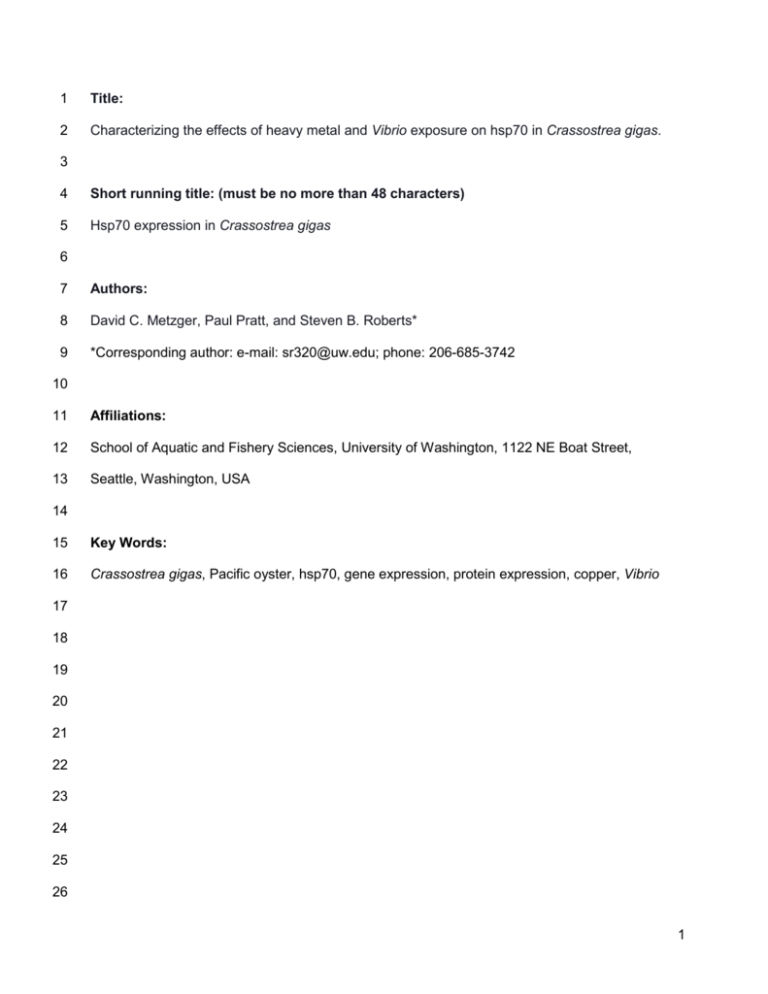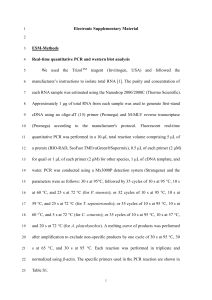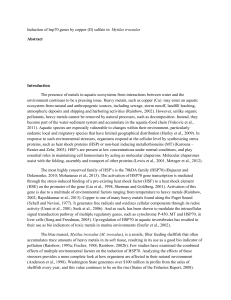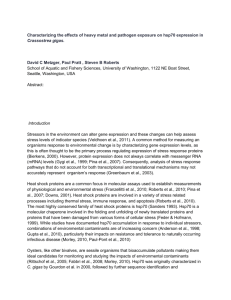Cgigas Cu hsp70 draft8 _SR 87KB Nov 17 2011 04
advertisement

1 Title: 2 Characterizing the effects of heavy metal and Vibrio exposure on hsp70 in Crassostrea gigas. 3 4 Short running title: (must be no more than 48 characters) 5 Hsp70 expression in Crassostrea gigas 6 7 Authors: 8 David C. Metzger, Paul Pratt, and Steven B. Roberts* 9 *Corresponding author: e-mail: sr320@uw.edu; phone: 206-685-3742 10 11 Affiliations: 12 School of Aquatic and Fishery Sciences, University of Washington, 1122 NE Boat Street, 13 Seattle, Washington, USA 14 15 Key Words: 16 Crassostrea gigas, Pacific oyster, hsp70, gene expression, protein expression, copper, Vibrio 17 18 19 20 21 22 23 24 25 26 1 27 Abstract: 28 The Pacific oyster, Crassostrea gigas, is an intertidal bivalve mollusc inhabiting several 29 continents. Similar to other shellfish, the Pacific oyster is considered an important bioindicator 30 species. One way to assess environmental perturbations is to examine an organism’s stress 31 response. Molecular chaperones, including heat shock proteins, are common targets when 32 evaluating an organism’s response to environmental stress. In this study, oysters were exposed 33 to copper and the bacteria Vibrio tubiashii to examine how these environmental stressors 34 influence Hsp70 gene and protein expression. Bacterial exposure did not effect Hsp70 35 expression, while copper exposure significantly changed both transcript and protein level. 36 Interestingly, copper exposure increased gene expression and decreased protein levels when 37 compared to controls. The dynamics of Hsp70 regulation observed here provide important 38 insight into heavy metal exposure, heat shock protein activity, and highlight considerations that 39 should be made when using Hsp70 as an indicator of an organism’s general stress response. 40 41 42 Introduction Perturbations in environmental conditions can alter physiological processes and 43 measuring these changes can provide information with respect to an organism’s response to 44 stress. A common means to characterize a physiological response to environmental change is 45 by measuring changes in gene expression levels, since mRNA expression is considered directly 46 related to corresponding protein levels (Bierkens, 2000). However, protein expression does not 47 always correlate with messenger RNA (mRNA) levels (Gygi et al., 1999; Piña et al., 2007). 48 Consequently, analysis of stress response pathways that do not account for both transcriptional 49 and translational mechanisms may not accurately represent the organism’s response 50 (Greenbaum et al., 2003). 51 2 52 Heat shock proteins (Hsp) are a common focus in assays used to establish 53 measurements of physiological and environmental stress (Franzellitti et al., 2010; Roberts et al., 54 2010; Piña et al., 2007; Downs, 2001). Heat shock proteins are involved in a variety of stress- 55 related processes including thermal stress, immune response, and apoptosis (Feder & 56 Hofmann, 1999; Roberts et al., 2010). The most highly conserved family of heat shock proteins 57 is the Hsp70 family(Sanders 1994). Hsp70s are molecular chaperones involved in the folding 58 and unfolding of newly translated proteins, and proteins that have been damaged from various 59 forms of cellular stress (Feder & Hofmann, 1999). Hsp70 was originally characterized in C. 60 gigas by Gourdon et al. (2000), followed by further sequence identification and characterization 61 by Boutet et al. (2003). Hsp70 is one of the most targeted proteins for studying the stress 62 response in shellfish (Fabbri et al., 2008). 63 Oysters, like other bivalves, are sessile organisms that are continually filtering water and 64 often bioaccumulate toxins, making them ideal bioindicator species (Rittschof et al., 2005; 65 Fabbri et al., 2008; Morley, 2010). While studies have documented Hsp70 accumulation in 66 response to individual stressors such as temperature and heavy metals (Clegg et al.,1998: 67 Boutet et al., 2003), fewer studies have characterized Hsp70 in organisms that are subjected to 68 multiple stressors. Combinations of environmental contaminants can act synergistically, the 69 effects of which can be greater than the sum of the individual stressors combined (Anderson et 70 al., 1998). As combinations of stressors are more representative of natural ecosystems, 71 characterizing physiological stress response in the presence of multiple stressors is relevant to 72 understanding stress response physiology (Anderson et al., 1998; Gupta et al., 2010). 73 The primary objective of the current study was to characterize Hsp70 activity at the 74 transcript and protein levels in C. gigas when exposed to copper and bacteria. Copper is one of 75 several heavy metal contaminants found in aquatic environments (O’Connor & Lauenstein, 76 2005). The bacterial pathogen Vibrio tubiashii (Vt), is a re-emergent bacterial pathogen of 77 shellfish on the west coast of North America (Elston et al., 2008). This study provides insight 3 78 into heavy metal exposure in shellfish, heat shock protein activity, and highlights considerations 79 that should be made when using Hsp70 as an indicator for an organism’s general stress 80 response. 81 82 Materials and Methods 83 Experimental design 84 Pacific oysters were collected from the University of Washington’s field station at Big 85 Beef Creek, WA in November 2010. A total of 32 oysters were collected with a mean length of 86 112.3mm. Following four days of acclimation in 12oC seawater, oysters were randomly assigned 87 to four treatment groups (n=8). One group received a dose of copper(II) sulfate (33mg/L copper 88 ion concentration) for 72 hours. A second group of oysters were subjected to a Vibrio tubiashii 89 (Strain ATTC 19106) bath exposure at 7.5x105 CFU/ml for 24 hours. A third group of oysters 90 was subjected to both the copper and Vt exposure. The fourth group of oysters served as a 91 control and was held in seawater for the duration of the experiment. Vt was cultured overnight at 92 37°C in 1 liter LB broth, plus an additional 1% NaCl. Cells were harvested by centrifugation at 93 4,200 rpm for 20min. Pelleted bacteria were then re-suspended in 0.22um filter sterilized 94 seawater. Immediately following treatments, gill tissue was removed and stored at -80°C for 95 subsequent RNA and protein extraction. 96 97 98 cDNA synthesis and quantitative PCR analysis RNA from all gill tissue samples (~25mg) was extracted using TRI Reagent (Molecular 99 Research Center, Inc., Cincinnati, OH) following the manufacturer’s protocol. RNA samples 100 were treated with the Turbo DNA-free Kit (Ambion Inc., Foster City, CA) per manufacturer’s 101 recommended standard protocol to remove potential genomic DNA carryover. RNA (1ug) was 102 reverse transcribed using M-MLV reverse transcriptase (Promega, Madison, Wisconsin) 103 according to the manufacturer’s protocol. For gene expression analysis, primers were designed 4 104 for heat shock protein 70 (GenBank Accession # AJ318882) 105 (hsp70fw:TGGCAACCAATCGCAAGGTGAG; hsp70rv: CCTGAGAGCTTGAGGACAAGGT) 106 using Primer3 software (Rozen & Skaletsky, 2000). Quantitative PCR (qPCR) reactions were 107 carried out in a CFX96 Real-Time PCR Detection System (Bio-Rad, Hercules, CA). Each 25-µl 108 reaction contained 1X Immomix Master Mix (Bioline USA Inc., Boston, MA), 0.2 µM of each 109 primer, 0.2 µM Syto-13 (Invitrogen, Carlsbad, CA), 2 µl of cDNA, and sterile water. 110 Thermocycling conditions included an initial denaturation (10 min at 95ºC), followed by 40 111 cycles of 15 sec at 95ºC, 15 sec at 55ºC, and 30 sec at 72ºC, with fluorescence measured at 112 the end of annealing and extension steps. Following qPCR, melting curve analysis was 113 performed by increasing the temperature from 65ºC to 95ºC at a rate of 0.2ºC per second, 114 measuring fluorescence every 0.5ºC. All samples were run in duplicate. Analysis of qPCR data 115 was carried out based upon the kinetics of qPCR reactions (Zhao & Fernald, 2005)) and 116 normalized to elongation factor 1 alpha expression (ef1fw: AAGGAAGCTGCTGAGATGGG; 117 ef1rv: CAGCACAGTCAGCCTGTGAAGT (GenBank Accession # AB122066). DNased RNA 118 was used as template to insure the no genomic DNA carryover was present. Data are 119 expressed as fold increases over the minimum. 120 121 122 Protein isolation and Western Blot Analysis Protein was extracted from gill tissue using CellLytic Cell Lysis Reagent tissue (Sigma, 123 St Louis, MO) containing protease inhibitor cocktail (Sigma) at a ratio of 1:20 (1g tissue/20ml 124 reagent). The levels of Hsp70 protein were assessed by Western blot analysis using anti-heat 125 shock protein 70 monoclonal antibody (3A3) (Product # MA3-006) (Pierce, Thermo Fisher 126 Scientific, Rockford, IL). Total protein was subjected to gel electrophoresis using 4-20% Precise 127 Protein Gels (Precise, Thermo Fisher Scientific, Rockford, IL). Gels were transferred to 128 nitrocellulose membranes, blocked and incubated with diluted (1:3000) primary hsp70 antibody. 129 Membrane incubations and visualization were carried using the WesternBreeze Chromogenic 5 130 Kit - Anti-Mouse (Invitrogen, Carlsbad, CA). Integrated density values were calculated using 131 Image J (Rasband, W.S.). Values of background densities on SDS-PAGE gels were calculated 132 and used to normalize values based on protein band density. 133 134 135 Statistical analysis Two-way ANOVA analyses were carried out to determine significant differences in 136 Hsp70 mRNA expression and protein levels (p<0.05) (SPSS v18). As no effect of Vt was 137 detected for either hsp70 mRNA expression or protein levels, data from Vt exposed oysters was 138 combined with control oysters while data from Vt and copper exposed oysters was combined 139 with the copper exposed oysters and a t-test was conducted to determine the effect of copper 140 exposure on Hsp70 expression (p<0.05). 141 142 Results 143 Vibrio Exposure 144 Heat shock protein 70 gene and protein levels were not significantly different in gill tissue 145 from oysters exposed to only Vt when compared to controls (data not shown). Furthermore, 146 mRNA expression and protein levels in gill tissue from oysters exposed to Vt in combination 147 with copper were not significantly different from oysters exposed to copper alone. As there was 148 no influence of the Vt exposure on Hsp70 mRNA expression or protein levels, subsequent 149 analyses and data presented from copper exposed oysters will refer to those oysters exposed to 150 copper only (n=8), and the group of oysters exposed to copper and Vt (n=8). 151 152 153 154 Copper Exposure Copper exposure significantly altered both gene and protein expression. Specifically, expression of hsp70 mRNA was significantly higher in copper treated oysters compared to 6 155 control individuals (Figure 1a). Protein expression was significantly decreased in gill tissue from 156 oysters exposed to copper compared to controls (Figure 1b). 157 158 159 Discussion While Hsp70 expression has received considerable attention as an indicator of stress in 160 shellfish, there are limited studies that characterize both gene and protein Hsp70 expression. 161 This study demonstrates that exposure to copper influences Hsp70 gene and protein expression 162 in oysters. Furthermore, exposure to copper resulted in discordant expression of Hsp70 mRNA 163 and protein. 164 Oysters used in this study were exposed to 33mg/L of copper and this resulted in a 165 significant increase in hsp70 mRNA expression. This result is similar to what has been observed 166 in other shellfish. In Argopecten purpuratus, Zapata et al. (2009) observed that exposure of 167 copper as low as 2.5 μg/L for eight days showed significant increases in hsp70 mRNA. 168 Driessena polymorpha exposed to copper had significantly increased expression of hsp70 169 mRNA in gill tissue after 24 hours of exposure that returned to control levels after 7 days 170 (Navarro et al., 2011). A study on Fenneropenaeus chinensis showed a significant increase in 171 hsp70 mRNA in shrimp exposed to 20μg/L copper after 24 hours of exposure, however 72 172 hours of exposure actually decreased expression levels (Luan et al., 2010). The decrease in 173 gene expression level in Fenneropenaeus chinensis could be attributed the toxicity threshold 174 being exceeded, impairing general biological processes including transcription. In the current 175 study, the increased expression of hsp70 mRNA following 72 hours of a relatively high dose of 176 copper could indicate resilience in the ability to respond high levels of copper exposure. 177 Assuming that hsp70 gene expression would no longer be affected by a specific environmental 178 stressor, an interesting future research direction would be to examine this hypothesis across 179 numerous stressors. 7 180 Changes in Hsp70 protein levels in shellfish exposed to copper appear to be taxa and 181 dose dependent. The concentration of Hsp70 protein in this study was significantly lower in the 182 gill tissue of copper exposed oysters compared to controls. These results are consistent with 183 other studies of C. gigas in which decreased levels of Hsp70 protein were observer in oysters 184 exposed to lower levels of copper (Boutet et al., 2003). However, in in other bivalves, copper 185 exposure has resulted in an increase in Hsp70 protein concentration. Zebra mussels exposed to 186 100-500ug/L copper showed increased Hsp70 protein levels while no change was detected in 187 lower doses (Clayton et al., 2000). Protein levels for Hsp70 were also elevated in Mytilus edulis 188 after 7 days exposure to copper (Sanders, 1994). In Chamelea gallina, a concentration 189 dependent regulation of protein expression was observed in which protein concentrations 190 increased in the presence of low copper concentrations (<1mg/ml) and decreased in high 191 copper treatments (>5mg/ml) (Rodriguez-Ortega et al., 2003). This could indicate that, 192 independent of species, Hsp70 protein can perform appropriate biological functions related to 193 stress response and protein damage. However, in the oyster, Hsp70 protein integrity appears to 194 be more sensitive to a range of copper concentrations compared to other shellfish species 195 despite the expression of hsp70 mRNA. 196 Copper is known to cause cytopathological damage to gill tissue (Spicer & Weber, 1991; 197 Sanders, 1994; Pawert et al., 1996; Triebskorn and Köhler, 1996; Quig, 1998) as the result of 198 peroxidation reactions that produce free radicals that damage lipids and proteins (Donato,1981). 199 The observed discordant expression of hsp70 mRNA with Hsp70 protein levels could therefore 200 be due to the rate of Hsp70 protein degradation in the cytoplasm exceeding the rate of hsp70 201 mRNA transcription. Copper exposure could be damaging Hsp70 proteins themselves or the 202 overall translational machinery (Lewis et al., 2001), which would result in lower protein levels. 203 Copper has also been shown to interfere with RNA transcriptional machinery and RNA integrity 204 (Viarengo, 1985). Results from this study suggest that the transcriptional machinery in oysters is 8 205 quite robust as expression of hsp70 mRNA was observed at levels above that of control 206 animals. 207 This study illustrates that environmental stressors can influence Hsp70 gene and protein 208 expression in a discordant fashion. We did not observe an effect of Vt exposure on hsp70 209 expression, and presumably the bacterial exposure did not significantly impact the physiological 210 response to copper. The influence of copper on Hsp70 regulation in oysters appears to be 211 different compared to closely related species, which could offer an interesting system to study 212 Hsp70 dynamics in greater detail. Understanding the mechanisms responsible for this apparent 213 difference in the sensitivity of Hsp70 regulation between species could help us better 214 understand mechanisms underlying species resilience. These findings highlight important 215 considerations that should be taken when using Hsp70 as an indicator of environmental stress 216 the associated physiological response. 217 218 219 220 221 222 223 224 225 226 227 228 229 230 9 231 References 232 Anderson, R.S., L.L. Bruacher, L.R. Calvo, M.A. Unge & E.M. Burreson. 1998. 233 Effects of tributyltin and hypoxia on the progression of Perkinsus marinus infections and 234 host defense mechanisms in oyster, Crassostrea virginica (Gmelin). J. Fish Dis. 21:371- 235 380. 236 237 238 Bierkens, J.G.E.A. 2000. Applications and pitfalls of stress-proteins in biomonitoring. Toxicology 153:61-72. Boutet, I., A. Tanguy, S. Rousseau, M. Auffret & D. Moraga. 2003. Molecular 239 identification and expression of heat shock cognate 70 (hsc70) and heat shock protein 240 70 (hsp70) genes in the Pacific oyster Crassostrea gigas. Cell Stress & Chaperones 241 8(1):76-85. 242 Clayton, M.E., R. Steinmann, & F. Fent. 2000. Different expression patterns of heat 243 shock proteins hsp 60 and hsp 70 in zebra mussels (Dreissena polymorpha) exposed to 244 copper and tributyltin. Aquatic Toxicology 47:2130-226. 245 Clegg, J.S., K.R. Uhlinger, S.A. Jackson, G.N. Cherr, E. Rifkin, & C.S. Friedman. 1998. 246 Induced thermotolerance and the heat shock protein-70 family in the Pacific oyster 247 Crassostrea gigas. Mol. Mar. Biol. Biotechnol. 7:21-30. 248 249 250 Donato, H. 1981. Lipid peroxidation, cross-linking reactions and aging. Age Pigments 63-100. Downs, C.A., J.E. Fauth & C.M. Woodley. 2001. Assessing the health of grass shrimp 251 (Palaeomonetes pugio) exposed to natural and anthropogenic stressors: a molecular 252 biomarker system. Mar. Biotech. 3:380-397. 253 Elston R.A., H. Hasegawa, K.L. Humphrey, I.K. Polyak & C.C. Hase. 2008. Re-emergence 254 of Vibrio tubiashii in bivalve shellfish aquaculture: severity, environmental drivers, 255 geographic extent and management. Dis.Aquat.Org. 82:119-134. 256 Fabbri, E., P. Valbonesi & S. Franzellitti. 2008. HSP expression in bivalves. ISJ 5:1351 0 257 258 161. Feder, M.E. & G.E. Hofmann. 1999. Heat-shock proteins, molecular chaperones, and 259 the stress response: evolutionary and ecological physiology. Annu. Rev. Physiol. 260 61:243-282. 261 Franzellitti, S., S. Buratti, F. Donnini E. Fabbri. 2010. Exposure of mussels to a 262 polluted environment: insights into the stress syndrome development. Comp. Biochem 263 and Phys. Part C 152:24-33. 264 Gourdon, I., L. Gricourt, K. Kellner, P. Roch & J.M. Escoubas. 2000. Characterization of 265 a cDNA encoding a 72 kDa heat shock cognate protein (Hsc72) from the Pacific oyster, 266 Crassostria gigas. DNA Seq. 11:265-270. 267 268 269 270 271 272 273 274 275 Greenbaum D, C. Colangelo, K. Williams & M. Gerstein. 2003. Comparing protein abundance and mRNA expression levels on a genomic scale. Genome Biol 4(9):117. Gupta, S.C., A. Sharma, M. Mishra & R.K. Mishra. 2010. Heat shock proteins in toxicology: How close and how far? Life Sciences 86:377-384. Gygi, S.P., Y. Rochon, B.R. Franza & R. Aebersold. 1999. Correlation between Protein and mRNA abundance in yeast. Mol. Cell. Biol. 39(3):1720-1730. Lewis S., M.E. Donkin & M.H. Depledge. 2001. Hsp70 expression in Enteromorpha intestinalis (Chlorophyta) exposed to environmental stressors. Aquat Toxicol 51:277-291. Luan, W., F. Li, J. Zhang, R. Wen, Y. Li & J. Xiang. 2010. Identification of a novel inducible 276 cytosolic Hsp70 gene in Chinese shrimp Fenneropenaeus chinensisI and comparison of 277 its expression with the cognate Hsc70 under different stresses. Cell Stress & 278 Chaperones 15:83-93. 279 280 Morley, NJ. 2010. Interactive effects of infectious diseases and pollution in aquatic molluscs. Aquat Toxicol 96: 27-36. 281 Navarro, A., M. Faria, C. Barata & B. Piña. 2011. Transcriptional response of stress genes to 282 metal exposure in zebra mussel larvae and adults. Enviro. Poll. 159:100-107. 1 1 283 284 285 O’Connor, T.P. & G.G. Lauenstein. 2005. Status and trends of copper concentrations in mussels and oysters in the USA. Marine Chemistry 97:49-59. Paul-Pont, I., X. de Montaudouin, P. Gonzalez, F. Jude, N. Raymond,C. Paillard, C. & M. 286 Baudrimont. 2010. Interactive effects of metal contamination and pathogenic organisms 287 on the introduced marine bivalve Ruditapes philippinarum in European populations. Env. 288 Pol. 158:3401-3410. 289 Pawert, M., R. Triebskorn, S. Gräff, M. Berkus, J. Schulz & H.R. Köhler. 1996. Cellular 290 alteration in collembolan midgut cells as a marker of heavy metal exposure: 291 ultrastructure and intracellular metal distribution. Sci. Tot. Environ. 181:187-200. 292 293 Piña, B., M. Casado & L. Quiros. 2007. Analysis of gene expression as a new tool in ecotoxicology and environmental monitoring. Trends Analyt. Chem. 26(11):1145-1154. 294 Quig, D. 1998. Cysteine metabolism and metal toxicity. Altern. Med. Rev. 3(4):262-270. 295 Rasband, W.S., ImageJ, U. S. National Institutes of Health, Bethesda, Maryland, USA, 296 297 298 299 http://imagej.nih.gov/ij/, 1997-2011. Rittschof, D. & P. McClellan-Green. 2005. Molluscs as multidisciplinary models in environment toxicology. Mar. Pol. Bull. 50:369-373. Roberts, R.J., C. Agius, C. Saliba, P. Bossier & Y.Y. Sung. 2010. Heat shock proteins 300 (chaperones) in fish and shellfish and their potential role in relation to fish health: a 301 review. J. Fish Dis. 33:789-801. 302 Rodriquez-Ortega, M.J., B.E. Grosvik, A. Rodriguez-Ariza, A. Goksoyr, & J. Lopez-Barea. 2003. 303 Changes in protein expression profiles in bivalve molluscs (Chamaelea gallina) exposed 304 to four model environmental pollutants. Proteomics 3:1535-1543. 305 Rozen S & H. Skaletsky. 2000. Primer3 on the WWW for general users and for biologist 306 programmers. In: Krawetz S, & S. Misener (eds) Bioinformatics Methods and Protocols: 307 Methods in Molecular Biology. Humana Press, Totowa, NJ, pp 365-386. 308 Sanders, B.M., L.S. Martin, S.R. Howe, W.G. Nelson, E.S. Hegre & D.K. Phelps. 1994. 1 2 309 Tissue-specific differences in accumulation of stress proteins in Mytilus edulis eposed to 310 a range of copper concentrations. Toxicol Appl Pharmacol 125:206-213. 311 Spicer, J.I. & R.E. Weber. 1991. Respiratory impairment in crustaceans and molluscs due to 312 exposure to heavy metals. Comp. Biochem. Physiol. Vol. C. 100(3):339-342. 313 Triebskorn, R. & H.R. Köhler. 1996. The impact of heavy metals on the grey garden 314 slug Deroceras reticulatum (Muller): metal storage, cellular effects and semi-quantitative 315 evaluation of metal toxicity. Environ. Pollut. 93:327-343. 316 Viarengo, A. 1985. Biochemical effects of trace metals. Mar. Pol. Bul. 16(4):153-158. 317 Zapata, M., A. Tanguy, E. David, D. Moraga & C. Riquelme. 2009. Transcriptomic response of 318 Argopecten purpuratus post-larvae to copper exposure under experimental conditions. 319 Gene 442:37–46. 320 321 Zhao S. & R.D. Fernald. 2005. Comprehensive algorithm for quantitative real-time polymerase chain reaction. J. Comp. Biol. 12(8):1045-62. 322 323 324 325 326 327 328 329 330 331 332 333 334 1 3 335 Figure 1. 336 337 338 339 340 341 342 1 4 343 Figure 1: 344 Quantification of hsp70 mRNA (A) and protein (B) in oysters held in sea water or in 33mg/l 345 copper. Expression values are presented as fold change over the minimum expression value +/- 346 standard error. “No copper” expression values include both control and Vt exposed animals 347 while “copper exposed” include both copper only and coppter and Vt treatesd animals as Vt 348 exposure was shown to have no significant effect on hsp70 expression by ANOVA analysis. 349 Asterisks denote significant difference in hsp70 expression value compared to “no copper” 350 treatment (p<0.05). 1 5




